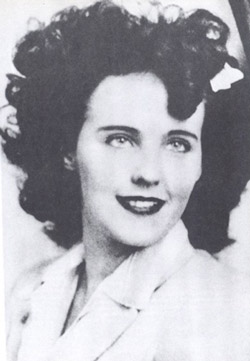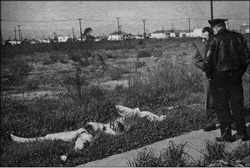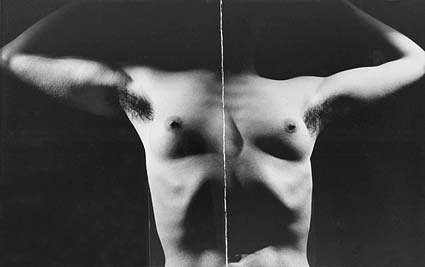
In 1940s America, the siren call of the Dream Factory lured Elizabeth Short from Massachusetts to Hollywood. Though the Dream Factory promised much, Elizabeth Short’s dreams were modest: to fall in love with a soldier and live happily ever after. Those who knew her during that time described her as “shy and sweet,” “immaculately dressed,” and someone who “didn’t smoke or drink.” In her letters to her fiancé Major Matt Gordon, she looked forward to their future together, writing in May 1945, “I love you, I love you, I love you. Sweetheart of all my dreams.”
But Elizabeth’s dream was destroyed when Gordon was killed in a plane crash on his way home from India. Although bereft, Elizabeth stayed in Hollywood and met someone else who would prove to be not her dream lover but rather the demon of her destruction. All these years later, the question of how the “good kid” Elizabeth Short crossed paths with a sadistic killer remains unanswered.
Newspapers referred to the murdered Elizabeth Short as the Black Dahlia, the name coined most probably by Elizabeth’s friends who were influenced by the 1946 movie The Blue Dahlia, and Elizabeth’s black hair and penchant for black clothes. Ironically, The Blue Dahlia also tells the story of a vicious murder. After Short’s death, the daily papers screamed headlines such as: “Police seek mad pervert in girl’s death,” (Washington Post 1/19/47), and the name Black Dahlia undoubtedly helped to keep the murder the lead story for many weeks.

Los Angeles Examiner reporter Will Fowler and photographer Felix Pagel were first on the scene, and their story and gruesome crime scene photos were published that same day. Such was the savagery of the murder that the photos were retouched with a blanket airbrushed onto the brutalized body.
If the placement of Elizabeth’s body was deliberate, its positioning was a puzzle. The posing of a dead body, even today, occurs in less than one percent of all homicides, and so it seems probable that Elizabeth Short’s killer was sending some kind of message. Her arms were raised above her head, the right arm at a forty-five degree angle away from the body and bent at the elbow to form a ninety degree angle, the left arm positioned the same way to form a second ninety degree angle; her mouth was slit open from ear to ear. Her body had been cut in half with the top half set twelve inches above the lower and slightly to the left of it. But what was the message?
The police never deciphered it. Many theories have been posited and dozens of books written about the murder. One credible decoding of the message and unmasking of the murderer comes from Steve Hodel in his book Black Dahlia Avenger and its sequels. Hodel claims that his father, Dr. George Hodel, killed not just Elizabeth Short but dozens of other women. The explanation of the body’s positioning, suggests Hodel, can be found in Surrealism, especially the work of Man Ray, a close friend of Dr. Hodel.

While I was at first skeptical of this evidence, I became more convinced of its validity the more closely I compared Man Ray’s photographs to the crime scene photos. Even more persuasive for me, George Hodel, thinking he was about to be arrested, left the country in 1951 and stayed away for 40 years while Man Ray left the United States in 1951 never to return.
Elizabeth Short was tortured, sexually mutilated, killed, and abandoned. Givenchy, as an ad for its perfume Dahlia Noir, has created a video that seems to draw from Short’s sad life. In it they fetishistically film a woman who appears to be writhing in pain. It’s decidedly creepy.
Rather than capitalize on her murder 65 years later, we should instead wish Elizabeth Short the peace in death she never found in life.
Susan Amper, author of How to Write About Edgar Allan Poe, still mourns the loss of her Nancy Drew collection.
Read all of Susan Amper’s posts for Criminal Element.

I agree Susan, decidely distasteful…. May Elizabeth be resting in peace already. I would NEVER buy anything named or advertised like this!
By the way Susan, what happened to your Nancy Drew collection? It is obviously traumatic!?!
sk1336–By the time I was 13 (and too old to read them anymore), I had a complete collection of the Nancy Drew books. Then high school and college came along, and I put the books away in the attic. When I moved into an apt. I went looking for them–I thought they would be cool on my shelves. I spent the next several years looking in our garage, our attic, and other places. I was sure they had to be somewhere. I found out about 10 years after college that my father had sold them at a garage sale. It was traumatic–I had spent time amassing that collection–but alas, it was gone for good. Probably just as well–I would have lugged those books from place to place, and I don’t have room enough for the books I have now.
But I did love those mysteries when I was a kid.
So sorry!!! Thanks for sharing! I adored Nancy Drew too, then kept going with the Hardy Boys, and so on and so on… Then I made my daughter into a bookie. My daughter had a big box of books that were most precious to her lost in a move when she was 11, it is now 14 years later and she still has not forgiven me!!! I am now the keeper of her collection since she moved up there to NYC, and I am constantly quizzed and doubted about their well-being! It is nice to know that I am not the only parent of an unhappy book lover!
Dahlia Noir–yuck. Thanks for this.
This story gives the creeps everytime I read about it. That poor young woman – what must she have gone through. To use her commercially to sell a product is revolting.
Giving the company the benefit of the doubt, the perfume could just be named for a scent inspired by a Dahlia flower, of which there is a burgundy-black breed, and the commercial could just be an avearge ultra-sexy perfume commercia like everyone from Dior to Elizabeth Taylor have done.
The tie to the artist is certainly interesting. But, I’m almost certain that the company would not knowingly make the connection, espicially being an French owned company and this being a crime that occured over 60 years ago in American History, and was largely unknown to the general public until the book and movie came out a few years ago. It’s unfortunate that the murder has colored the interpretation, but I don’t think we should start getting our pitch forks and torches just yet.
ShadeofPoe,
I wasn’t using a pitchfork; I was suggesting how the name of the perfume brought to [b]MY[/b] mind a connection to the Elizabeth Short story as do the bondage images in the ads–in some of them, the model is wearing a dog collar.
I hadn’t seen this article back in 2012 by Susan Amper. Well written and refreshingly accurate. I blogged the ad when it first came out in 2011. See original blog link here: http://stevehodel.com/2011/09/givenchy_launches_new_black_da/ My book, Black Dahlia Avenger was a national bestseller in France, in 2006 so they would have been very aware of Elizabeth Short and the surrealist connections I made to my father and his close friend Man Ray who was our family photography for a decade. Two follow up editions BDA II (2014) and BDA III (Nov 2018 soon to publish) have expanded the surrealist links to where now there is no doubt. Regards, Steve Hodel, Los Angeles